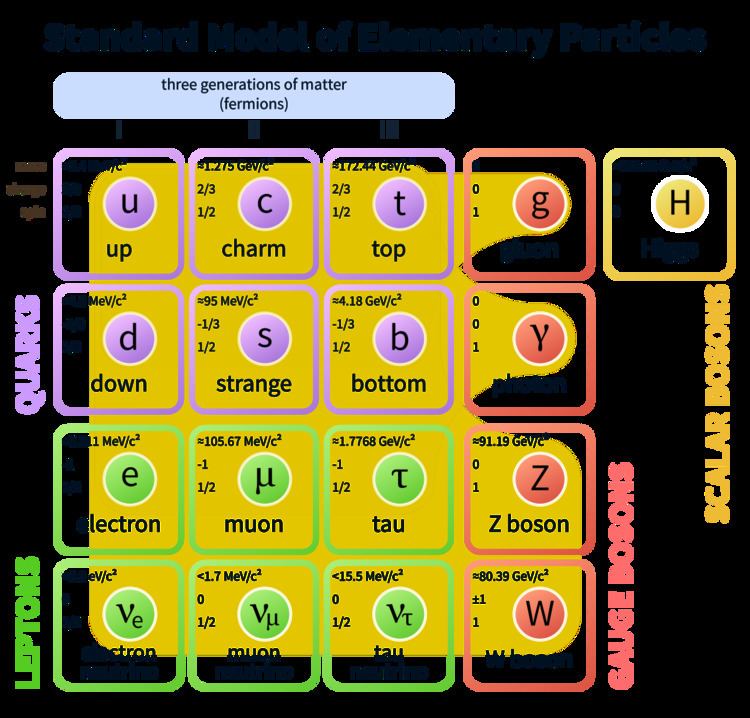 | ||
In particle physics, the electroweak interaction is the unified description of two of the four known fundamental interactions of nature: electromagnetism and the weak interaction. Although these two forces appear very different at everyday low energies, the theory models them as two different aspects of the same force. Above the unification energy, on the order of 100 GeV, they would merge into a single electroweak force. Thus, if the universe is hot enough (approximately 1015 K, a temperature exceeded until shortly after the Big Bang), then the electromagnetic force and weak force merge into a combined electroweak force. During the electroweak epoch, the electroweak force separated from the strong force. During the quark epoch, the electroweak force split into the electromagnetic and weak force.
Contents
Sheldon Glashow, Abdus Salam, and Steven Weinberg were awarded the 1979 Nobel Prize in Physics for their contributions to the unification of the weak and electromagnetic interaction between elementary particles. The existence of the electroweak interactions was experimentally established in two stages, the first being the discovery of neutral currents in neutrino scattering by the Gargamelle collaboration in 1973, and the second in 1983 by the UA1 and the UA2 collaborations that involved the discovery of the W and Z gauge bosons in proton–antiproton collisions at the converted Super Proton Synchrotron. In 1999, Gerardus 't Hooft and Martinus Veltman were awarded the Nobel prize for showing that the electroweak theory is renormalizable.
Formulation
Mathematically, the unification is accomplished under an SU(2) × U(1) gauge group. The corresponding gauge bosons are the three W bosons of weak isospin from SU(2) (W1, W2, and W3), and the B boson of weak hypercharge from U(1), respectively, all of which are massless.
In the Standard Model, the
W±
and
Z0
bosons, and the photon, are produced by the spontaneous symmetry breaking of the electroweak symmetry from SU(2) × U(1)Y to U(1)em, caused by the Higgs mechanism (see also Higgs boson). U(1)Y and U(1)em are different copies of U(1); the generator of U(1)em is given by Q = Y/2 + I3, where Y is the generator of U(1)Y (called the weak hypercharge), and I3 is one of the SU(2) generators (a component of weak isospin).
The spontaneous symmetry breaking makes the W3 and B bosons coalesce into two different bosons – the
Z0
boson, and the photon (γ),
Where θW is the weak mixing angle. The axes representing the particles have essentially just been rotated, in the (W3, B) plane, by the angle θW. This also introduces a mismatch between the mass of the
Z0
and the mass of the
W±
particles (denoted as MZ and MW, respectively),
The W1 and W2 bosons, in turn, combine to give massive charged bosons
The distinction between electromagnetism and the weak force arises because there is a (nontrivial) linear combination of Y and I3 that vanishes for the Higgs boson (it is an eigenstate of both Y and I3, so the coefficients may be taken as −I3 and Y): U(1)em is defined to be the group generated by this linear combination, and is unbroken because it does not interact with the Higgs.
Before electroweak symmetry breaking
The Lagrangian for the electroweak interactions is divided into four parts before electroweak symmetry breaking
The
where
where the subscript
The h term describes the Higgs field F.
The y term gives the Yukawa interaction that generates the fermion masses after the Higgs acquires a vacuum expectation value.
After electroweak symmetry breaking
The Lagrangian reorganizes itself after the Higgs boson acquires a vacuum expectation value. Due to its complexity, this Lagrangian is best described by breaking it up into several parts as follows.
The kinetic term
where the sum runs over all the fermions of the theory (quarks and leptons), and the fields
The neutral current
where the electromagnetic current
and
The charged current part of the Lagrangian is given by
and
Note the
